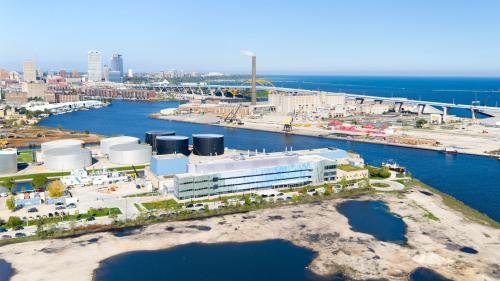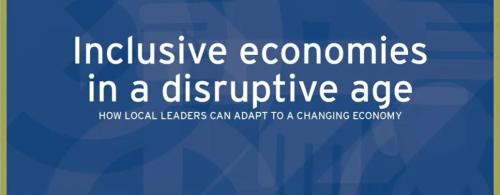Recently, I gave a keynote speech at the Mackinac Policy Conference on how to create inclusive economies in a disruptive era. Inclusive economies, as I defined them, are ones that maximize the participation of people, places, and businesses in economic growth, enabling people to be creators of opportunity, not just beneficiaries of growth. By producing new ideas, goods, services, and enterprises, people gain the means to be more robust consumers and provide a decent quality of life for themselves and their family, and in doing so, power the economy in a virtuous cycle. The problem is that too many members of our community remain excluded from participating fully in the economy. Meanwhile, disruptive market dynamics are transforming the rules of success and challenging how we help society adapt.
Accompanied by a set of explanatory graphics, here are some of the core messages from my speech:
 Building an inclusive economy is not just the responsibility of employers and economic development professionals: leaders in community development, workforce development, education, and land use planners also play crucial roles. Historically, groups focused on economic growth haven’t seen inclusion as part of their mandate, and groups focused on equity and inclusion haven’t trusted market actors, given the former’s often exclusionary legacy practices. Yet if we are to meaningfully achieve inclusive economies, these actors and systems must align and coordinate, which is something we are beginning to see happen in cities.
Building an inclusive economy is not just the responsibility of employers and economic development professionals: leaders in community development, workforce development, education, and land use planners also play crucial roles. Historically, groups focused on economic growth haven’t seen inclusion as part of their mandate, and groups focused on equity and inclusion haven’t trusted market actors, given the former’s often exclusionary legacy practices. Yet if we are to meaningfully achieve inclusive economies, these actors and systems must align and coordinate, which is something we are beginning to see happen in cities.
 Michigan’s metro areas are on the upswing. Greater Detroit, Grand Rapids, and Flint have experienced steady job gains the last five years, reversing a decade of consecutive job losses. Grand Rapids has more jobs today than it did before the recession.
Michigan’s metro areas are on the upswing. Greater Detroit, Grand Rapids, and Flint have experienced steady job gains the last five years, reversing a decade of consecutive job losses. Grand Rapids has more jobs today than it did before the recession.
 The jobs rebound is important; however, job quality matters even more, and it appears that all this job growth in Michigan metros is not resulting in greater productivity. In other words, the net income created per job has remained relatively flat in recent years, making it difficult for firms to raise wages or invest in training for their workers.
The jobs rebound is important; however, job quality matters even more, and it appears that all this job growth in Michigan metros is not resulting in greater productivity. In other words, the net income created per job has remained relatively flat in recent years, making it difficult for firms to raise wages or invest in training for their workers.

This may be one reason why median wages across Detroit, Grand Rapids, and Flint remain lower than they were back in 2000. There is no doubt that the strong job growth recently has helped stem the median wage loss in these markets, yet it’s clear we need more wage gains. Additionally, sizable gaps remain between whites and workers of color in every metro area.

Looking beyond the top-line numbers, though, it’s clear that the economic recovery has not reached all places equally. The number of high-poverty neighborhoods in both the city and the suburbs of metropolitan Detroit has increased over the past decade. Too many families live in neighborhoods that hamper their upward mobility.
This data suggests that broadly speaking, Michigan’s metro areas have been effective at reinvigorating economic growth since the recession. The task now is to ensure that growth translates into greater productivity and inclusion for more residents.

At the same time, a number of disruptive market forces threaten to exacerbate inequality and economic exclusion if we fail to respond. Technological innovation is rapidly changing the nature of work, rendering certain skills obsolete. McKinsey recently estimated that half of all existing tasks worldwide could be automated using today’s technologies, particularly middle-skills tasks like data processing, data collection and routine manual labor.
 Technology has also enabled the creation of global supply chains, in which R&D and parts production can take place in far-flung locations. This has made some U.S. firms vulnerable to expanded global competition, resulting in substantial job losses and extended periods of unemployment for workers in trade-vulnerable industries. More than 150,000 workers in Michigan received trade adjustment assistance. Nearly half of that group live in the Detroit metro area, while the rest are spread throughout the state.
Technology has also enabled the creation of global supply chains, in which R&D and parts production can take place in far-flung locations. This has made some U.S. firms vulnerable to expanded global competition, resulting in substantial job losses and extended periods of unemployment for workers in trade-vulnerable industries. More than 150,000 workers in Michigan received trade adjustment assistance. Nearly half of that group live in the Detroit metro area, while the rest are spread throughout the state.

Also, the workforce we need to prepare for this disruptive period is rapidly diversifying in metros across the country. In places like Los Angeles, Houston, and Atlanta, a majority of millennials–defined as residents between the ages of 18 and 35–are people of color. Our job training and worker adjustment policies need to help older white workers and younger, more diverse populations navigate the new rules of the 21st century economy.

How can city and regional leaders deepen and accelerate existing efforts to create inclusive economies in a disruptive age? As we at Brookings Metro see it, strategies should help people, places, and firms adapt and prosper.
- To help people, our strategies should equip them with the skills they need to take part in a fast-changing economy. This could include providing our young people with meaningful work experiences so they can improve their soft skills and expand their professional networks, or rewarding firms who hire ex-offenders.
- Place is also crucial to economic activity. Our strategies should connect neighborhoods in core cities and older suburbs to regional opportunities through better transit and access to affordable housing. A network of neighborhoods across a city or metro area could also serve as economic hubs themselves, so that residents, no matter where they live, can be close to opportunity.
- And there is a role for public policy and civic action to spur business dynamism, which means helping entrepreneurs launch new businesses and ensuring they, and mid-sized firms, survive and scale through periods of disruption. Rather than simply attract companies, leaders should create entrepreneurship ecosystems and help existing companies make productivity improvements, which can result in operational cost savings, higher revenues, and higher wages.
In closing, the forces of disruption are global, but their solutions are local. It is within cities that separate funding streams and programs are knit together to empower people, places, and businesses. It is within cities that leaders prize problem-solving over partisanship, and build trust and new collaborations. In an era of great uncertainty, one thing is certain: cities, with states and other partners in the public and private sectors, will lead the way in creating an America that expands opportunity for all.
Author’s note: This is an abbreviated version of my speech at the Mackinac Policy Conference. You can find the full presentation here, or watch the full remarks here.







Commentary
Building inclusive economies: My speech at Michigan’s Mackinac Policy Conference
June 26, 2017